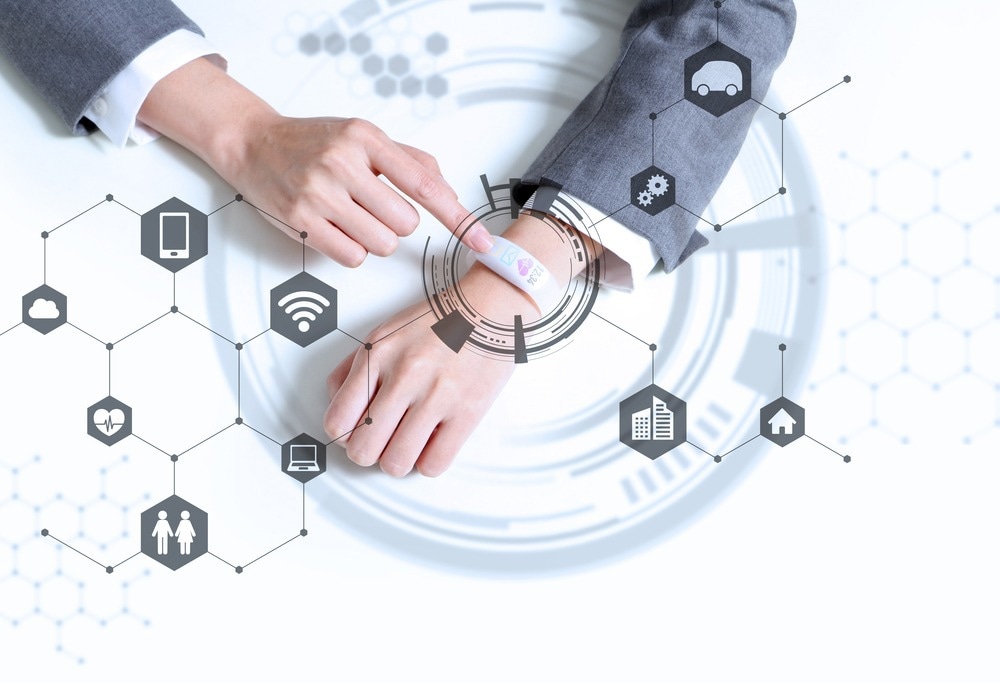We consider wearable technology to be a modern feat. However, its origins date back to the eyeglass, which was invented in 1286. Throughout the 20th century, ingenious wearables emerged, from computers small enough to fit inside a shoe to help gamblers cheat the game of roulette to the ground-breaking Sony Walkman that was released in 1979.
Today, several application areas of wearable sensors have become established. Possibly the most well-known technology in the wearable sensors market is the smartwatch. This application of wearable sensors is used by a wide consumer group across the globe. Its features include tracking fitness data and health monitoring (such as tracking heart rate).
The health industry has also leveraged developments in the wearable sensors market to create smart patches: a wearable device designed to be worn on the skin to track various health parameters as well as deliver medication.
Smart clothing is an emerging field that utilizes wearable sensor technology. Smart clothing features integrated sensors that track a range of biometric data, including heart rate, skin temperature, and respiration.

Image Credit: metamorworks/Shutterstock.com
Recent Developments in the Wearable Sensors Market
The wearable sensors market is currently experiencing significant growth. Recent developments in this field include advancements in materials used to produce sensors, which has led to them being smaller, more lightweight, and flexible, opening up more application possibilities in the wearable sensors market.
There has also been a trend in the wearable sensors market for developing applications in the healthcare setting. New, advanced wearables are emerging that are used in the management of chronic diseases, such as the continuous glucose monitors that are available from Medtronic, Dexcom, and Abbott for the management of diabetes.
Recently, researchers have begun developing more sophisticated sensors that are appropriate for being woven into fabric to provide precise and reliable measurements on several health parameters. As a result, the field of “smart clothes” has begun to emerge as one of the latest sectors of the wearable sensors market. Brands including Levi’s, Under Armour, Komodo, Owlet, and Ambiotex, including others, have entered this market.
Current Global Wearable Sensors Market
The global wearable sensors market was valued at $840 million in 2021. It is expected to grow rapidly at a CAGR of 18.3% to 2030, reaching a value of $3.7 billion. North America is currently the largest market, and Asia Pacific is the fastest-growing region.
Growth in the global wearable sensors market is currently being fueled by the trend of sensor miniaturization. With advancements in sensor materials, scientists can produce smaller sensors with enhanced capabilities, making them cheaper and suitable for a wider range of applications.
The growth of the Internet of Things (IoT) is also currently fueling growth in the wearable sensors market. Devices are more connected than ever before; smartphones can connect to a myriad of smart technologies that offer a range of functionalities. The wearable sensors market is benefitting from this, as it has developed infrastructure for wearable sensors to thrive.
Key players in the global wearable sensors market include Apple Inc., which makes the popular Apple Watch which uses a number of sensors for health and fitness tracking; Fitbit Inc., a leading manufacturer of fitness trackers and wearable sensors; Garmin Ltd., another leading manufacturer of fitness trackers and smartwatches; Samsung Electronics, also a key producer of smartwatches; Sony Corporation, a key player in hearable sensors, activity trackers, and smartwatches; Phillips Healthcare, which produces sensors for the remote monitoring of patients.

Image Credit: SFIO CRACHO/Shutterstock.com
Other notable companies in the global wearable sensors market include Google LLC, Microsoft Corporation, Huawei Technologies, TE. Connectivity LTD., NXP Semiconductors N.V., STMicroelectronics N.V., Robert Bosch GmbH, Infineon Technologies AG, InvenSense, Knowles Electronics, Panasonic Corporation, Sensirion AG, and Asahi Kasei Corporation.
Future Directions for the Wearable Sensors Market
The wearable sensors market will continue to grow and evolve as sensor technology advances and becomes more sophisticated. Perhaps the greatest drivers of future growth for the global wearable sensors market include increasing health consciousness around the globe. The is a drive for technology that can assist people in living healthier lives. The wearable sensors market will likely respond by developing sensors with improving functionalities concerning health tracking.
Additionally, there is increasing demand from the healthcare industry for technology that can facilitate the management of chronic diseases. In the future, the wearable sensors market will likely encompass a larger segment of healthcare and pharmaceuticals, and more advanced wearables will likely exist for remote patient monitoring.
Sports and performance tracking are also placing increasing demands on the wearable sensors market. In the coming years, we will likely see wearables developed to increase athletic performance, reduce the likeliness of injuries, and boost training programs.
The Wearable Sensors Market: Final Thoughts
Overall, the wearable sensors market is thriving, and there are a number of exciting current developments that will shape the market going forward. There is a focus on developing wearable technology for health and fitness purposes, which will continue to drive the wearable sensors market throughout the decade.
References and Further Reading
Guo, Y. et al. (2021) A review of wearable and unobtrusive sensing technologies for chronic disease management, Computers in Biology and Medicine, 129, p.104163. doi:10.1016/j.compbiomed.2020.104163.
Saha, T. et al. (2023) Wearable electrochemical glucose sensors in diabetes management: A comprehensive review, Chemical Reviews, 123(12), pp.7854–7889. doi:10.1021/acs.chemrev.3c00078.
The History of Wearable Technology [online]. Condeco. Available at: https://www.condecosoftware.com/blog/the-history-of-wearable-technology/
Wearable Sensors Market [online]. Straits Research. Available at: https://straitsresearch.com/report/wearable-sensors-market
Disclaimer: The views expressed here are those of the author expressed in their private capacity and do not necessarily represent the views of AZoM.com Limited T/A AZoNetwork the owner and operator of this website. This disclaimer forms part of the Terms and conditions of use of this website.